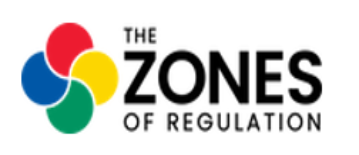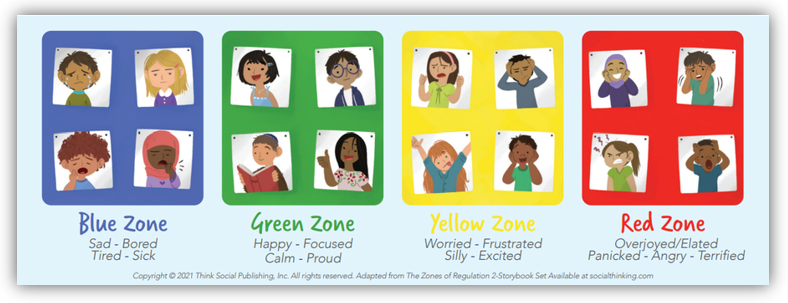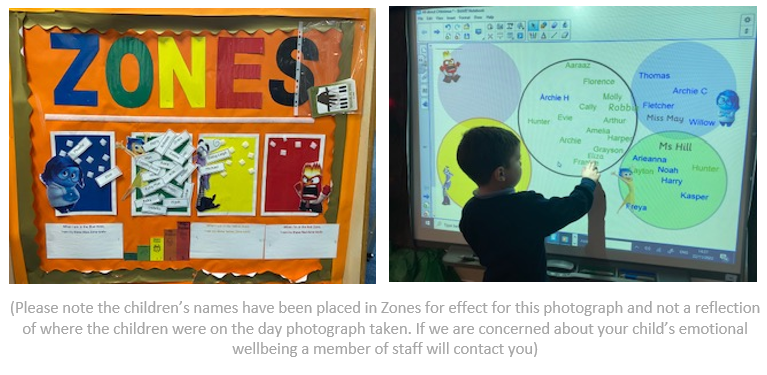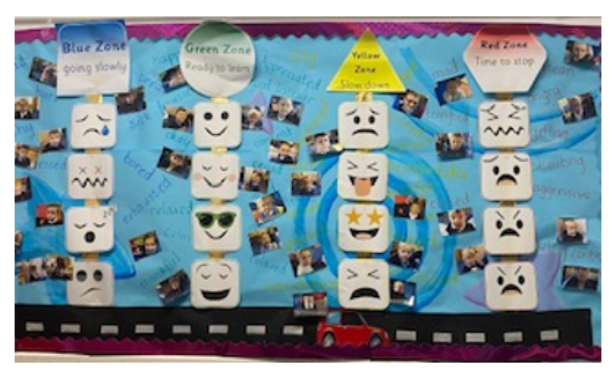
At Wild Bank, we use the Zones of Regulation to develop our pupil’s awareness of feelings, energy and alertness levels while exploring a variety of tools and strategies for regulation, prosocial skills, self-care, and overall wellbeing. We use the Zones of Regulation to help pupils to think and talk about how we feel on the inside and sort these feelings into four coloured Zones, all of which are expected in life. Being emotionally literate improves relationships, allows for better team work, helps pupils to deal with change, and facilitates the feeling of community. Once we understand our feelings and Zones, we can learn to use tools/strategies to manage our different Zones in order to meet goals like doing schoolwork or other tasks, managing big feelings, and healthy relationships with others. The simple, common language and visual structure of The Zones of Regulation helps make the complex skill of regulation more concrete for our pupils and those who support them

THE FOUR ZONES: OUR FEELINGS AND STATES DETERMINE OUR ZONE
The Red Zone is used to describe extremely heightened states of alertness and intense emotions. A person may be elated or experiencing anger, rage, devastation, or terror when in the Red Zone.
The Yellow Zone is also used to describe a heightened state of alertness and elevated emotions; however, one has more control when they are in the Yellow Zone. A person may be experiencing stress, frustration, anxiety, excitement, silliness, the wiggles, or nervousness when in the Yellow Zone.
The Green Zone is used to describe a calm state of alertness. A person may be described as happy, focused, content, or ready to learn when in the Green Zone. This is the zone where optimal learning occurs.
The Blue Zone is used to describe low states of alertness and down feelings such as when one feels sad, tired, sick, or bored.
Our children use Emotional Registers to show how they are feeling. Here are examples

The Zones can be compared to traffic signs. When given a green light or in the Green Zone, one is “good to go”. A yellow sign means be aware or take caution, which applies to the Yellow Zone. A red light or stop sign means stop, and when one is the Red Zone this often is the case. The Blue Zone can be compared to the rest area signs where one goes to rest or re-energise. All of the zones are natural to experience, but the framework focuses on teaching our pupils how to recognise and manage their Zone based on the environment and its demands and the people around them

How will my child learn about the Zones of Regulation?
The Zones of Regulation are taught through discrete teaching lessons and through our wider curriculum. We will also be using the Zones language as part of daily school life so all staff will be referring to them, not just their class teacher. For example, as the children are reading, they might talk about the character’s feelings and which Zone they are in.
Some children might prefer not to use the ‘Zones language’ but label the emotions directly – this is fine and encouraged!

How can you help your child use The Zones of Regulation at home?
- Identify your own feelings using Zones language in front of your child (e.g.: I’m frustrated. I think I am in the Yellow Zone.”)
- Talk about what tool you will use to be in the appropriate Zone (e.g.: “I need to take four deep breaths to help get me back to the Green Zone.”)
- At times, wonder which Zone your child is in. Or, discuss which Zone a character in a film / book might be in. (e.g.: “You look sleepy. Are you in the Blue Zone?”)
- Engage your child in discussion around Zones when they are in the Red Zone is unlikely to be effective. You need to be discussing the different Zones and tools they can use when they are more regulated / calm.
- Teach your child which tools they can you. (eg: “It’s time for bed. Let’s read a book together in the comfy chair to get you in the Blue Zone.”)
- Regular check-ins. “How are you feeling now?” and “How can you get back to Green?”
- Modelling It is important to remember to show the children how you use tools to get back to the Green Zones. You might say “I am going to make myself a cup of tea and do some breathing exercises because I am in the Blue Zone” and afterwards tell your child how using those tools helped you get back to the Green Zone.
- Share how their behaviour is affecting your Zone. For example, if they are in the Green Zone, you could comment that their behaviour is also helping you feel happy / go into the Green Zone.
- Put up and reference the Zones visuals and tools in your home.
- Praise and encourage your child when they share which Zone they are in.
Tips for practising the Zones of Regulation
- Know yourself and how you react in difficult situations before dealing with your child’s behaviours.
- Know your child’s sensory threshold. We all process sensory information differently and it impacts our reactivity to situations.
- Know your child’s triggers.
- Be consistent in managing your child’s behaviour and use the same language you use at home.
- Empathise with your child and validate what they are feeling.
- Have clear boundaries/routines and always follow through.
- Do not deal with an angry, upset child when you are not yet calm yourself.
- Discuss strategies for the next time when you are in a similar situation.
- Remember to ask your child how their choices made you feel (empathy).
- Praise your child for using strategies. Encourage your child to take a sensory break to help regulate their bodies.
- Create a ‘calm’ box full of things which help to keep your child calm and alert. Advice about what could go in the box can be found on the Zones of Regulation website in the ‘Zones Toolkit’ section.
Common questions about the Zones of Regulation
Can my child be in more than one zone at the same time?
Yes. Your child may feel tired (Blue Zone) because they did not get enough sleep, and anxious (Yellow Zone) because they are worried about an activity at school. Listing more than one Zone reflects a good sense of personal feelings and alertness levels.
Should children be punished for being in the Red Zone?
It’s best for children to experience the natural consequences of being in the Red Zone. If a child’s actions/choices hurt someone or destroys property, they need to repair the relationship and take responsibility for the mess they create. Once the child has calmed down, use the experience as a learning opportunity to process what the child would do differently next time.
Can you look like one Zone on the outside and feel like you are in another Zone on the inside?
Yes. Many of us “disguise” our Zone to match social expectations. We use the expression “put on a happy face” or mask the emotion so other people will have good thoughts about us. Parents often say that their children “lose it” and goes into the Red Zone as soon as they get home. This is because children are increasing their awareness of their peers and expectations when in the classroom. They make every effort to keep it together at school to stay in the Green Zone. Home is when they feel safe to let it all out.
Tools for Developing Coping Skills
As part of our learning about the Zones of Regulation, children will get to choose ‘tools’ to go in their toolkits. These ‘tools’ aren’t just for school: they can be used at home too so you can help your child to regulate (manage) their emotions.
What would go in your Zones of Regulation toolkit? Think about:
- What helps you to calm down when you are stressed?
- What helps you to focus when you are tired?
- What do you do to calm down when you are angry?
Different tools work for different people. Can you help your child choose what works for them when they need to move from one Zone to another?
Use the link below to explore lots of ideas for helping your child to regulate their emotions including:
- Sensory tools
- Breathing techniques
- Grounding techniques
- Calming activities
- Thinking techniques
